D-Link DIR-809 User manual
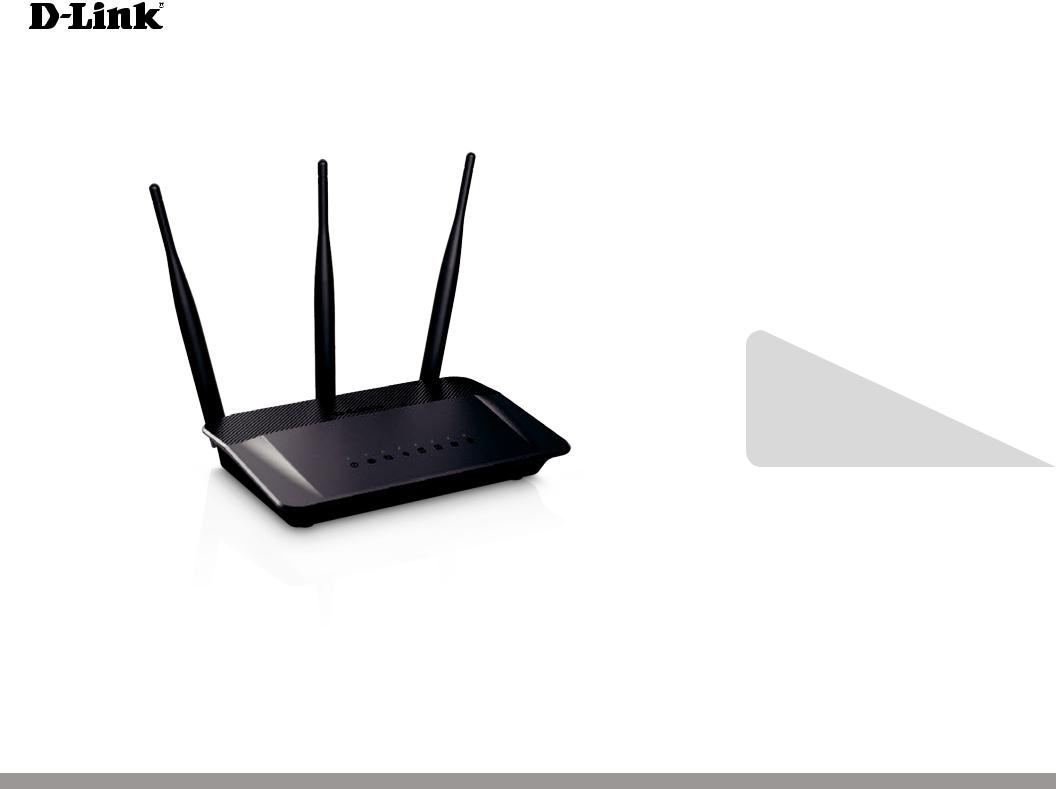
Version 1.03 | 2016/04/28
User Manual
Wireless AC750 Dual Band Router
DIR-809

Preface
D-Link reserves the right to revise this publication and to make changes in the content hereof without obligation to notify any person or organization of such revisions or changes.
Manual Revisions
Revision |
Date |
Description |
1.02 |
October 27, 2015 |
• Initial release for revision A3 |
|
|
|
1.03 |
April 28, 2016 |
• Content revision and correction |
|
|
|
Trademarks
D-Link and the D-Link logo are trademarks or registered trademarks of D-Link Corporation or its subsidiaries in the United States or other countries. All other company or product names mentioned herein are trademarks or registered trademarks of their respective companies.
Copyright © 2016 by D-Link Corporation, Inc.
All rights reserved. This publication may not be reproduced, in whole or in part, without prior expressed written permission from D-Link Corporation, Inc.
D-Link DIR-809 User Manual |
i |

Table of Contents
Table of Contents
Preface.................................................................................. |
i |
Product Overview.............................................................. |
1 |
Package Contents......................................................................... |
1 |
System Requirements.................................................................. |
2 |
Introduction.................................................................................... |
3 |
Features............................................................................................ |
4 |
Hardware Overview...................................................................... |
5 |
Connections............................................................................ |
5 |
LEDs............................................................................................ |
6 |
Installation.......................................................................... |
7 |
Before you Begin........................................................................... |
7 |
Wireless Installation Considerations...................................... |
8 |
Manual Setup................................................................................. |
9 |
Configuration................................................................... |
11 |
Easy Setup Wizard....................................................................... |
12 |
Internet Connection........................................................... |
13 |
Wireless Connection........................................................... |
13 |
Advanced Network Configuration........................................ |
15 |
Internet Connection Type (Manual Configuration).17 |
|
Dynamic IP (DHCP)........................................................ |
18 |
Static (assigned by ISP)................................................. |
19 |
PPPoE (Username / Password)................................... |
20 |
PPTP.................................................................................... |
22 |
L2TP..................................................................................... |
24 |
Wireless Settings.................................................................. |
26 |
Wireless Router Mode................................................... |
26 |
Access Point Mode......................................................... |
27 |
Repeater Mode................................................................ |
28 |
Wireless Router Mode........................................................ |
29 |
2.4G Wireless Network Settings................................ |
29 |
5G Wireless Network Settings.................................... |
30 |
Wireless Security.................................................................. |
31 |
What is WPA?.................................................................... |
31 |
2.4G/5G Wireless Security Mode............................... |
32 |
AP Mode................................................................................. |
34 |
Repeater 2.4 GHz Mode.................................................... |
35 |
Repeater 5 GHz Mode........................................................ |
37 |
Network Settings................................................................. |
39 |
Router Settings................................................................ |
39 |
DHCP Server Settings.................................................... |
40 |
DHCP Reservation.......................................................... |
41 |
Advanced............................................................................... |
42 |
Virtual Server.................................................................... |
42 |
Port Forwarding.............................................................. |
43 |
Application Rules............................................................ |
44 |
MAC Filter.......................................................................... |
45 |
Website Filters................................................................. |
46 |
Traffic Control.................................................................. |
47 |
Firewall Settings.............................................................. |
48 |
2.4G Advanced Wireless............................................... |
50 |
D-Link DIR-809 User Manual |
ii |

Table of Contents
5G Advanced Wireless.................................................. |
51 |
Advanced Network Settings....................................... |
52 |
Wi-Fi Protected Setup........................................................ |
54 |
Wi-Fi Protected Setup Wizard......................................... |
55 |
Tools......................................................................................... |
57 |
Admin................................................................................. |
57 |
Time..................................................................................... |
58 |
System................................................................................ |
59 |
Firmware............................................................................ |
60 |
Language Pack................................................................ |
60 |
Dynamic DNS................................................................... |
61 |
System Check................................................................... |
62 |
Status....................................................................................... |
63 |
Device Info........................................................................ |
63 |
Logs..................................................................................... |
64 |
Statistics............................................................................. |
65 |
Internet Sessions............................................................ |
66 |
Wireless.............................................................................. |
67 |
Support................................................................................... |
68 |
Connect a Wireless Client to your Router....................... |
69 |
WPS Button................................................................................... |
69 |
Windows® 8................................................................................... |
70 |
WPA/WPA2............................................................................. |
70 |
Windows® 7................................................................................... |
72 |
WPA/WPA2............................................................................. |
72 |
WPS.......................................................................................... |
75 |
Windows Vista®............................................................................ |
79 |
WPA/WPA2............................................................................. |
80 |
WPS/WCN 2.0........................................................................ |
82 |
Windows® XP................................................................................ |
83 |
WPA/WPA2............................................................................. |
84 |
Troubleshooting............................................................... |
86 |
Wireless Basics.................................................................. |
90 |
What is Wireless?......................................................................... |
91 |
Tips................................................................................................... |
93 |
Wireless Modes............................................................................ |
94 |
Networking Basics............................................................ |
95 |
Check your IP address................................................................ |
95 |
Statically Assign an IP address................................................ |
96 |
Technical Specifications................................................... |
97 |
D-Link DIR-809 User Manual |
iii |

Section 1 - Product Overview
ProductPackageOverviewContents
DIR-809 Wireless AC750 Dual Band Router
Ethernet Cable
Power Adapter
Wi-Fi Configuration Note |
Wi-Fi Configuration Note |
CD-ROM
If any of the above items are missing, please contact your reseller.
Note: Using a power supply with a different voltage rating than the one included with the DIR-809 will cause damage and void the warranty for this product.
D-Link DIR-809 User Manual |
1 |

Section 1 - Product Overview
System Requirements
• An Ethernet-based Cable or DSL modem
Network Requirements • IEEE 802.11ac, 802.11a, 802.11n or 802.11g wireless clients
• 10/100 Ethernet
Computer with the following:
•Windows®, Apple® Mac OS®, or Linuxbased operating system
•An installed Ethernet adapter
Web-based Configuration
Utility Requirements Browser Requirements:
Microsoft Internet Explorer® 9, Mozilla® Firefox® 20.0,
Google® Chrome® 25.0, or Safari® 5.1 or higher version
Windows® Users: Make sure you have the latest version of Java installed. Visit www.java.com to download the latest version.
D-Link DIR-809 User Manual |
2 |

Section 1 - Product Overview
Introduction
The D-Link DIR-809 is a IEEE 802.11ac compliant device that delivers up to three times faster speeds than 802.11n while staying backward compatible with 802.11a/g/b devices. Connect the DIR-809 to a Cable or DSL modem and provide high-speed Internet access to multiple computers, game consoles, and media players. Create a secure wireless network to share photos, files, music, videos, printers, and network storage. Powered by the 802.11ac technology this router provides wireless coverage for homes and offices, or for users running bandwidth-intensive applications.
With some routers, all wired and wireless traffic, including VoIP, Video Streaming, Online Gaming, and Web browsing are mixed together into a single data stream. By handling data this way, applications like video streaming could pause or delay. With D-Link Intelligent QoS Technology, wired and wireless traffic are analyzed and separated into multiple data streams.
The DIR-809 supports the latest wireless security features to help prevent unauthorized access, be it from over a wireless network or the Internet. Support for WPA™ and WPA2™ standards ensure that you will be able to use the best possible encryption regardless of your client devices. In addition, this router utilizes Dual Active Firewalls (SPI and NAT) to prevent potential attacks from across the Internet so you and your family can browser the Internet with peace-of-mind.
D-Link DIR-809 User Manual |
3 |

Section 1 - Product Overview
Features
•Ultimate Fast Wireless Networking - The DIR-809 provides up to 300 Mbps wireless bandwidth in the 2.4 GHz band and up to 433 Mbps wireless bandwidth in the 5 GHz band with other 802.11ac and draft 802.11n wireless clients. This capability allows users to participate in real-time activities online, such as video streaming, online gaming, and real-time audio. The performance of this 802.11ac wireless router gives you the freedom of wireless networking at speeds 3x faster than 802.11n.
•Compatible with 802.11a/g/n Devices - The DIR-809 is compatible with the IEEE 802.11a, 802.11g, and 802.11n wireless standards, so it can connect with existing networking devices as well as PCI, USB, and CardBus network adapters.
•Advanced Firewall Features - The Web-based user interface displays a number of advanced network management features including:
•Content Filtering - Easily applied content filtering based on MAC address or URL.
•Secure Multiple/Concurrent Sessions - The DIR-809 can pass through VPN sessions. It supports multiple and concurrent IPSec and PPTP sessions, so users behind the DIR-809 can securely access corporate networks.
•User-friendly Easy Setup Wizard - Through its easy-to-use Web-based user interface, the DIR-809 lets you quickly and easily configure your router, letting you surf the Internet within minutes.
*Maximum wireless signal rate derived from IEEE Standard 802.11a, 802.11g, 802.11n and draft 802.11ac specifications. Actual data throughput will vary. Network conditions and environmental factors, including volume of network traffic, building materials and construction, and network overhead, lower actual data throughput rate. Environmental conditions will adversely affect wireless signal range.
D-Link DIR-809 User Manual |
4 |
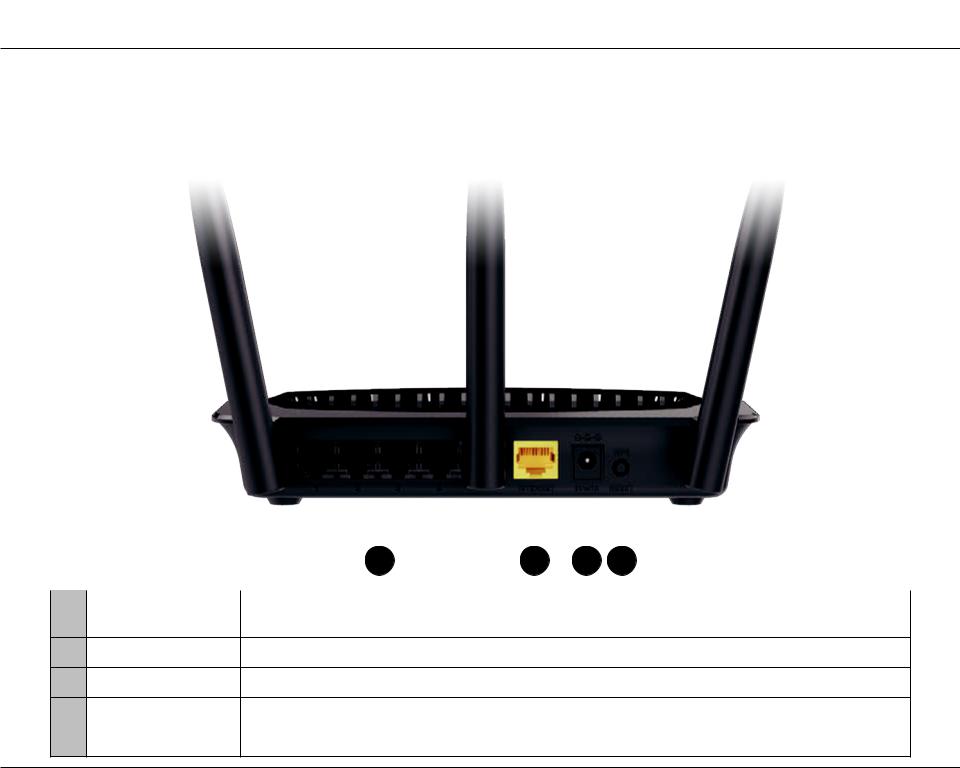
Section 1 - Product Overview
Hardware Overview
Connections
|
|
|
|
|
|
|
|
|
|
|
|
|
|
|
|
|
|
|
|
|
2 |
3 |
4 |
||||||
|
1 |
||||||||
|
|
|
|
|
|
|
|
||
1 LAN Ports (1 - 4) |
Connect 10/100 Ethernet devices such as computers, switches, storage (NAS) devices |
||||||||
|
and game consoles. |
|
|
|
|
|
|
||
2Internet Port Using an Ethernet cable, connect your broadband modem to this port.
3Power Connector Connector for the supplied power adapter.
4 |
WPS & Reset |
Press and hold the button for 1-7 seconds to activate WPS-PBC Discovery Mode. |
|
Button |
Press and hold the button for at least 8 seconds to reset the router to default settings. |
||
|
|||
|
|
D-Link DIR-809 User Manual |
5 |

Section 1 - Product Overview
Hardware Overview
LEDs
1 |
2 |
3 |
4 |
5 |
1Power LED A solid green light indicates a proper connection to the power supply.
2Internet LED A solid light indicates connection on the Internet port.
3 |
WPS LED |
This LED blinks during WPS handshake phase. |
4 |
WLAN |
A solid light indicates that the wireless segment is ready. |
|
|
|
5 |
Local Network LEDs A solid light indicates a connection to an Ethernet-enabled computer on ports 1-4. |
|
D-Link DIR-809 User Manual |
6 |

Section 2 - Installation
Installation
This section will walk you through the installation process. Placement of the router is very important. Do not place the router in an enclosed area such as a closet, cabinet, or in an attic or garage.
Before you Begin
•Please configure the router with the computer that was last connected directly to your modem.
•You can only use the Ethernet port on your modem. If you were using the USB connection before using the router, then you must turn off your modem, disconnect the USB cable and connect an Ethernet cable to the Internet port on the router, and then turn the modem back on. In some cases, you may need to call your ISP to change connection types (USB to Ethernet).
•If you have DSL and are connecting via PPPoE, make sure you disable or uninstall any PPPoE software such asWinPoet, Broadjump, or Enternet 300 from your computer or you will not be able to connect to the Internet.
D-Link DIR-809 User Manual |
7 |

Section 2 - Installation
Wireless Installation Considerations
The D-Link wireless router lets you access your network using a wireless connection from virtually anywhere within the operating range of your wireless network. Keep in mind, however, that the number, thickness and location of walls, ceilings, or other objects that the wireless signals must pass through, may limit the range. Typical ranges vary depending on the types of materials and background RF (radio frequency) noise in your home or business. The key to maximizing wireless range is to follow these basic guidelines:
1.Keep the number of walls and ceilings between the D-Link router and other network devices to a minimum - each wall or ceiling can reduce your adapter’s range from 3-90 feet (1-30 meters.) Position your devices so that the number of walls or ceilings is minimized.
2.Be aware of the direct line between network devices. A wall that is 1.5 feet thick (.5 meters), at a 45-degree angle appears to be almost 3 feet (1 meter) thick. At a 2-degree angle it looks over 42 feet (14 meters) thick! Position devices so that the signal will travel straight through a wall or ceiling (instead of at an angle) for better reception.
3.Building Materials make a difference. A solid metal door or aluminum studs may have a negative effect on range. Try to position access points, wireless routers, and computers so that the signal passes through drywall or open doorways. Materials and objects such as glass, steel, metal, walls with insulation, water (fish tanks), mirrors, file cabinets, brick, and concrete will degrade your wireless signal.
4.Keep your product away (at least 3-6 feet or 1-2 meters) from electrical devices or appliances that generate RF noise.
5.If you are using 2.4 GHz cordless phones or X-10 (wireless products such as ceiling fans, lights, and home security systems), your wireless connection may degrade dramatically or drop completely. Make sure your 2.4 GHz phone base is as far away from your wireless devices as possible. The base transmits a signal even if the phone in not in use.
D-Link DIR-809 User Manual |
8 |

Section 2 - Installation
Manual Setup
1. Turn off and unplug your cable or DSL broadband modem. This is required.
Modem
2.Position your router close to your modem and a computer. Place the router in an open area of your intended work area for better wireless coverage.
3.Unplug the Ethernet cable from your modem (or existing router if upgrading) that is connected to your computer. Plug it into the LAN port labeled 1 on the back of your router. The router is now connected to your computer.
DIR-809
Computer
D-Link DIR-809 User Manual |
9 |

Section 2 - Installation
4.Plug one end of the included blue Ethernet cable that came with your router into the yellow port labeled INTERNET on the back of the router. Plug the other end of this cable into the Ethernet port on your modem.
Computer |
DIR-809 |
|
|
Modem |
|
INTERNET |
|
5.Reconnect the power adapter to your cable or DSL broadband modem and wait for two minutes.
6.Connect the supplied power adapter into the power port on the back of the router and then plug it into a power outlet or surge protector. The power LED will light up. Allow 1 minute for the router to boot up.
Computer
DIR-809
Modem
INTERNET
7.If you are connecting to a Broadband service that uses a dynamic connection (not PPPoE), you may be online already. Try opening a web browser and enter a web site address.
D-Link DIR-809 User Manual |
10 |

Section 3 - Configuration
Configuration
There are several different ways you can configure your router to connect to the Internet and connect to your clients:
•D-Link Easy Setup Wizard - This wizard will launch when you log into the router for the first time. Refer to page 12.
•Manual Setup - Log into the router and manually configure your router (advanced users only). Refer to page 15.
D-Link DIR-809 User Manual |
11 |
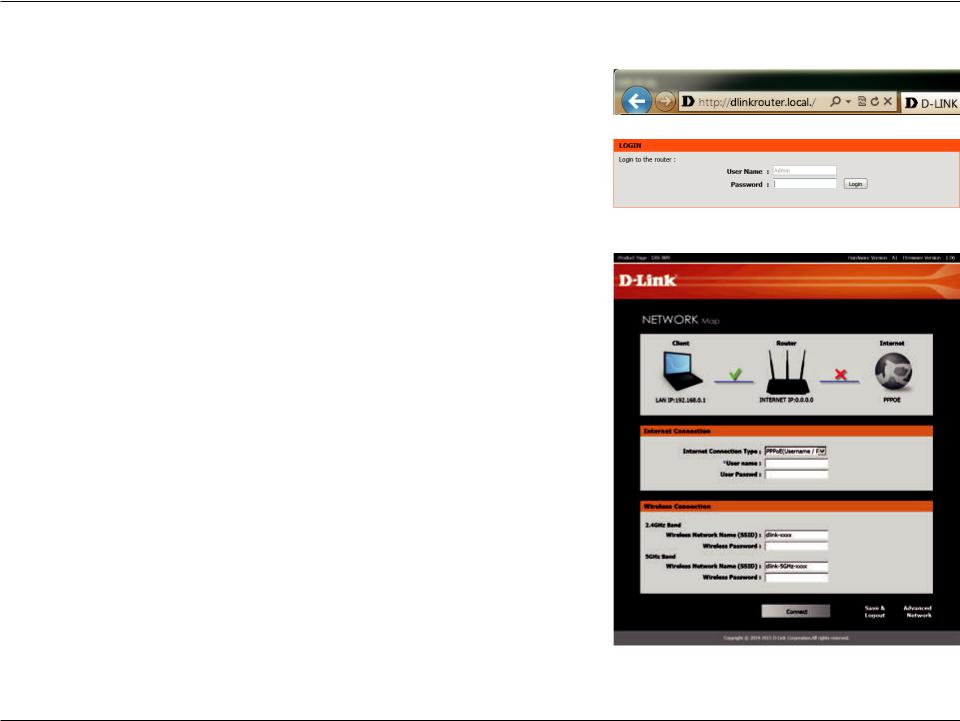
Section 3 - Configuration
Easy Setup Wizard
If this is your first time using the router, open your web browser. You will automatically be directed to the Wizard Setup Screen. If not, type http:// dlinkrouter.local./ or 192.168.0.1 into the address bar and press Enter. The username, “admin” will already be filled in. Leave the password blank and press the login button.
If you would like to manually set up the router, please refer to the Web-Based Configuration Utility section on page 15.
The Easy Setup Wizard consists of two parts: Internet Connection and Wireless
Connection.
D-Link DIR-809 User Manual |
12 |
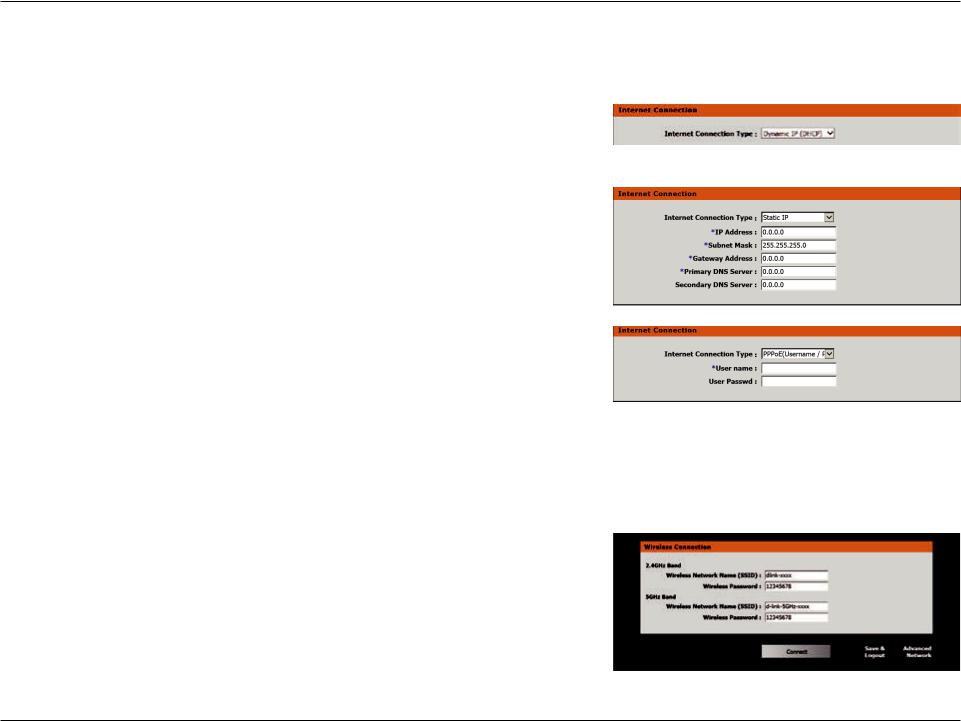
Section 3 - Configuration
Internet Connection
First select the INTERNET connection type. The options are Static IP, Dynamic IP (DHCP), and PPPoE(Username / Password).
Dynamic IP (DHCP)
The router will attempt to automatically configure itself for Dynamic IP Internet Connections.
Static IP
Enter the IP and DNS settings supplied by your ISP.
PPPoE
Enter your username and user password details provided by your Internet
Service Provider. This option is typically used for DSL Internet service.
Note: Make sure to remove your PPPoE software from your computer. The software is no longer needed and will not work through a router.
Wireless Connection
Next, create a Wi-Fi network name (SSID) for both the 2.4 GHz and 5 GHz segments using up to 32 characters.
Create a Wi-Fi password (between 8-63 characters). Your wireless clients will need to have this passphrase or key in order to connect to your wireless network.
Click Connect to continue.
D-Link DIR-809 User Manual |
13 |
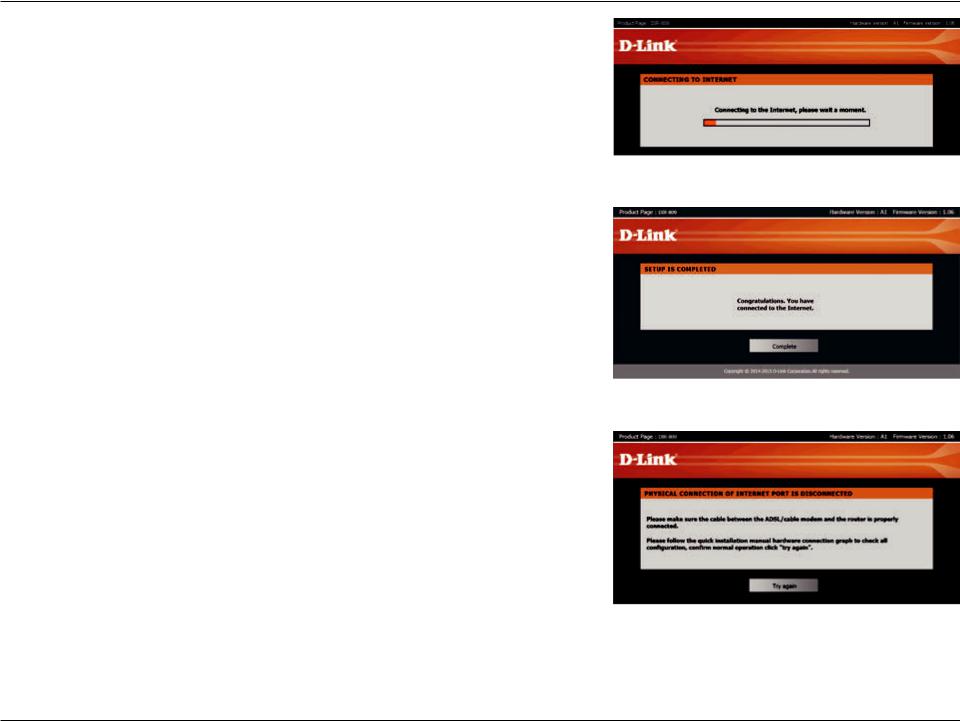
Section 3 - Configuration
Please wait while your router detects your Internet connection type. If you selected PPPoE as your Internet connection, you may need to enter information provided by you ISP, such as username and password.
Congratulations, your router setup is complete. Upon clicking Complete you will be redirected to the www.dlink.com may now freely use the Internet.
If the router does not detect a valid Ethernet connection from the Internet port, this screen will appear. Verify your broadband modem is connected to the Internet port and then click Try Again.
D-Link DIR-809 User Manual |
14 |
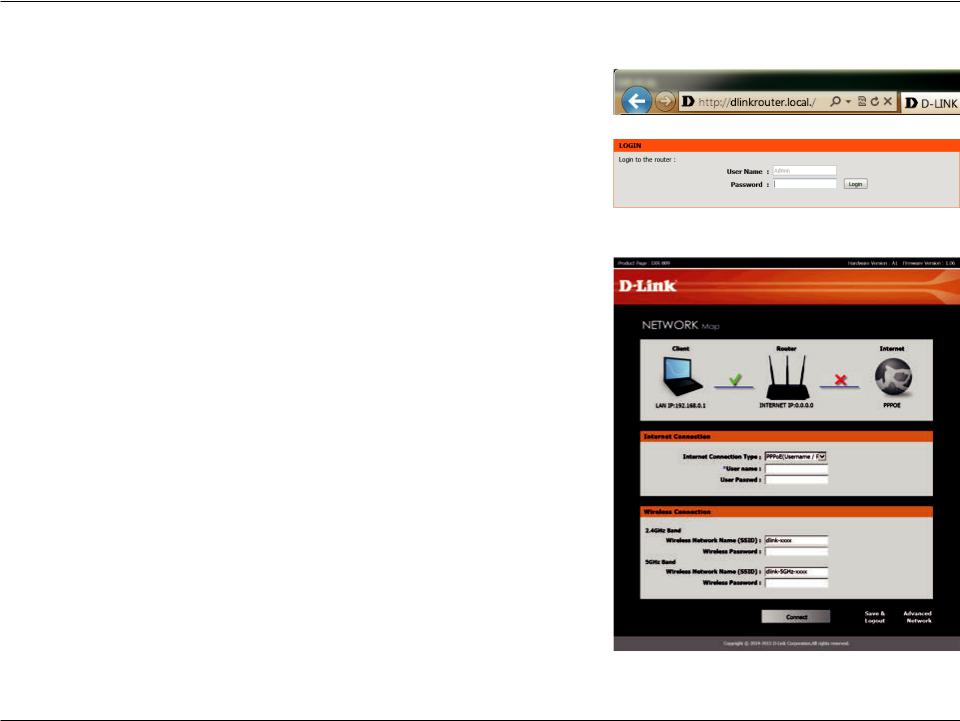
Section 3 - Configuration
Advanced Network Configuration
If this is your first time using the router, open your web browser. You will automatically be directed to the Wizard Setup Screen. If not, type http:// dlinkrouter.local./ or 192.168.0.1 into the address bar and press Enter. The username, “admin” will already be filled in. Leave the password blank and press the login button.
Upon login, bypass the Easy Setup by clicking Advanced Network in the bottom right hand corner of the page.
D-Link DIR-809 User Manual |
15 |

Section 3 - Configuration
Upon clicking the “Advanced Network” option, you will be brought to the Setup - Internet page. From this page you can configure your connection and router settings manually.
If you want to configure your router to connect to the Internet using the wizard, click Easy Setup. You will be directed back to the Easy Setup Wizard. Refer to the previous section.
D-Link DIR-809 User Manual |
16 |

Section 3 - Configuration
Internet Connection Type (Manual Configuration)
Internet Connection Type
In this section, the user can select from a list of Internet Connection types that can be configured and used on this router. Options to choose from are
Static IP, Dynamic IP, PPPoE, PPTP, and L2TP.
After selecting a specific Internet Connection type, this page will automatically refresh and provide unique fields to configure related to the specified Internet Connection type.
At any given point the user can save the configuration by clicking on the Save Settings button. If you choose to discard the changes made, click on the Don’t Save Settings button.
D-Link DIR-809 User Manual |
17 |

Section 3 - Configuration
Dynamic IP (DHCP)
My Internet Connection is: Dynamic IP (DHCP)
This option allows the router to obtain an IP address automatically from the WAN device that is connected to the Internet port.
Note: If you’re not sure about the type of Internet Connection you have, please contact your Internet Service Provider (ISP) for assistance.
After selecting Dynamic IP, the following parameters will be available for configuration:
Host Name: The Host Name is optional but may be required by some ISPs. Leave blank if you are not sure.
MAC The default MAC Address is set to the Internet port’s physical interface Address: MAC address on the Broadband Router. It is not recommended that you
change the default MAC address unless required by your ISP. You can use the Clone Your PC’s MAC Address button to replace the Internet port’s MAC address with the MAC address of your Ethernet card.
Primary DNS: Enter the Primary DNS IP address used here.
Secondary Enter the Secondary DNS IP address used here. This field is normally DNS: optional. Only one DNS address is required for a functional Internet connection, but using a second DNS address provides more stability.
MTU: Maximum Transmission Unit - you may need to change the MTU for optimal performance with your specific ISP. 1500 is the default MTU.
D-Link DIR-809 User Manual |
18 |
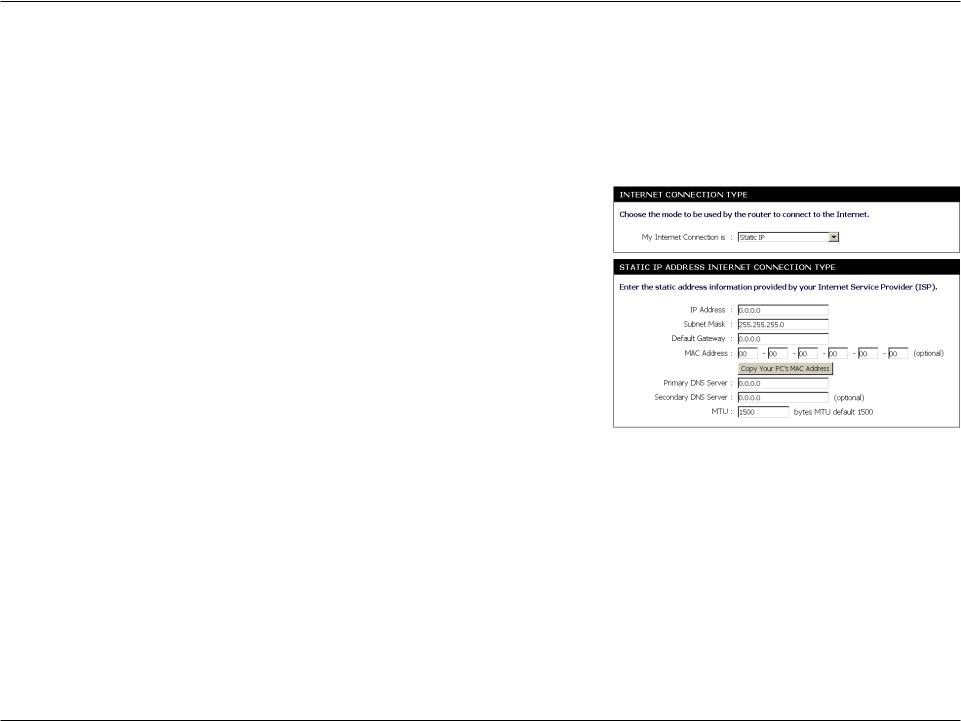
Section 3 - Configuration
Static (assigned by ISP)
My Internet Connection is: Static IP
Select Static IP Address if all the Internet port’s IP information is provided to you by your ISP. You will need to enter in the IP address, subnet mask, gateway address, and DNS address(es) provided to you by your ISP. Each IP address entered in the fields must be in the appropriate IP form, which are four octets separated by a dot (x.x.x.x). The Router will not accept the IP address if it is not in this format.
My Internet Select Static IP to manually enter the IP settings supplied by your ISP.
Connnection
IP Address: Enter the Static IP address provided by the ISP here.
Subnet Mask: Enter the Subnet Mask provided by the ISP here.
Default Enter the Gateway IP address provided by the ISP here.
Gateway:
MAC Address: The default MAC Address is set to the Internet port’s physical interface MAC address on the Broadband Router. It is not recommended that you change the default MAC address unless required by your ISP. You can use the Copy Your PC’s MAC Address button to replace the Internet port’s MAC address with the MAC address of your Ethernet card.
Primary Enter the Primary DNS IP address used here.
DNS Address:
Secondary Enter the Secondary DNS IP address used here. This field is normally op- DNS Address: tional. Only one DNS address is required for a functional Internet connec-
tion, but using a second DNS address provides more stability.
MTU: Maximum Transmission Unit - you may need to change the MTU for optimal performance with your specific ISP. 1500 is the default MTU.
D-Link DIR-809 User Manual |
19 |

Section 3 - Configuration
PPPoE (Username / Password)
Choose PPPoE (Point to Point Protocol over Ethernet) if your ISP uses a PPPoE connection. Your ISP will provide you with a username and password. This option is typically used for DSL services. Make sure to remove your PPPoE software from your computer. The software is no longer needed and will not work through a router.
My Internet Select PPPoE (Username/Password) from the drop-down menu.
Connection:
Address Here the user can specify whether this Internet connection requires the
Mode: use of a Dynamic or Static IP address. PPPoE usually requires a Dynamic
IP configuration.
Username: Enter the PPPoE account user name used here. This information is given by the ISP.
Password: Enter the PPPoE account password used here. This information is given by the ISP.
Confirm Re-enter the PPPoE account password used here.
Password:
Service This optional field enables the user to enter a service name to identify this
Name: Internet connection here.
IP Address: Enter the PPPoE IP address used here. This option is only available if Static
IP is selected.
MAC The default MAC Address is set to the Internet port’s physical interface Address: MAC address on the Broadband Router. It is not recommended that you
change the default MAC address unless required by your ISP. You can use the Copy Your PC’s MAC Address button to replace the Internet port’s MAC address with the MAC address of your Ethernet card.
D-Link DIR-809 User Manual |
20 |

Section 3 - Configuration
DNS Mode: This option allow the router to obtain the DNS IP addresses from the ISP, when Receive DNS from ISP is selected, or allows the user to enter DNS IP address manually, when Enter DNS Manually is selected.
Primary DNS Enter the Primary DNS IP address used here.
Server:
Secondary Enter the Secondary DNS IP address used here. This field is normally op- DNS Server: tional. Only one DNS address is required for a functional Internet connection, but using a second DNS address provides more stability.
Maximum Enter a maximum idle time during which the Internet connection is main- Idle Time: tained during inactivity.
MTU: Maximum Transmission Unit - you may need to change the MTU for optimal performance with your specific ISP. 1492 is the default MTU.
Connection Use the radio buttons to specify the reconnect mode. The user can select
Mode Select Always On, Manual, or Connection-on Demand.
D-Link DIR-809 User Manual |
21 |

Section 3 - Configuration
PPTP
Choose PPTP (Point-to-Point-Tunneling Protocol ) if your ISP uses a PPTP connection. Your ISP will provide you with a username and password. This option is typically used for DSL services.
My Internet Select PPTP (Username/Password) from the drop-down menu.
Connection:
Address Select Dynamic (most common) or Static. Select Static if your ISP as- Mode: signed you the IP address, subnet mask, gateway, and DNS server ad-
dresses.
PPTP IP Enter the IP address (Static PPTP only).
Address:
PPTP Subnet Enter the primary and secondary DNS server addresses (Static PPTP only).
Mask:
PPTP Enter the gateway IP address provided by your ISP (Static only).
Gateway IP
Address:
Primary DNS The DNS server information will be supplied by your ISP (Internet Service
Server: Provider.)
MAC The default MAC address is set to the WAN’s physical interface MAC ad- Address: dress on the broadband router. It is not recommended that you change
the default MAC address unless required by your ISP.
You can use the Copy Your PC’s MAC Address button to copy the MAC address of the Ethernet card installed by your ISP and replace the WAN MAC address with the MAC address of the router. It is not recommended that you change the default MAC address unless required by your ISP.
PPTP Server Enter the server IP address provided by your ISP (optional).
IP Address:
D-Link DIR-809 User Manual |
22 |
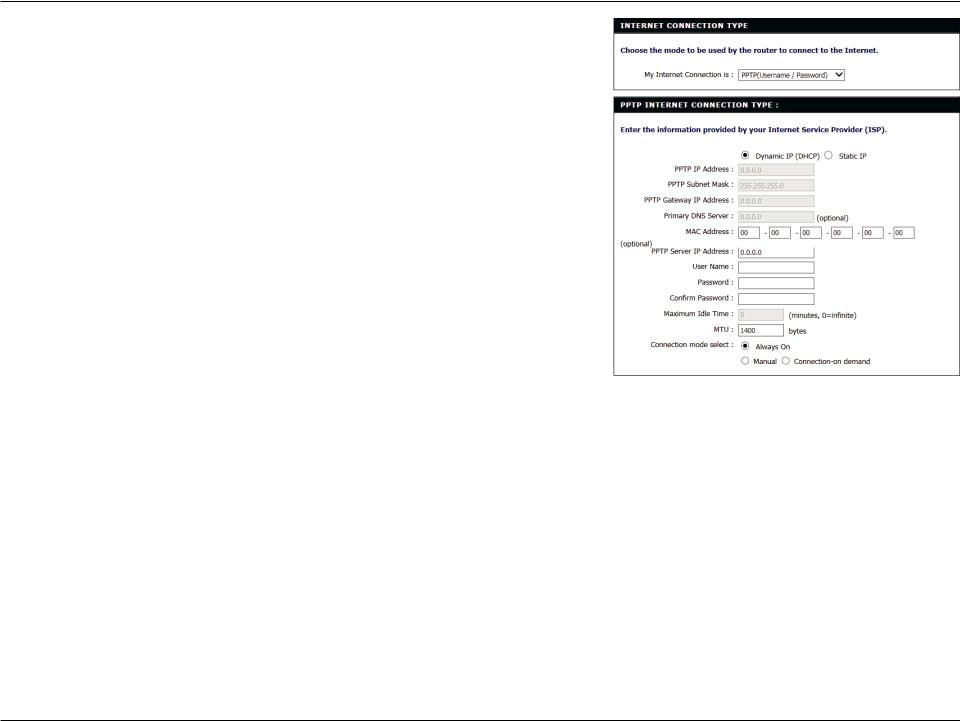
Section 3 - Configuration
User Name: Enter your PPTP account name.
Password: Enter your PPTP password, then retype the password in the next box.
Maximum Enter a maximum idle time during which the Internet connection is main- Idle Time: tained during inactivity.
MTU: Maximum Transmission Unit - You may need to change the MTU for optimal performance.
Connect Select either Always-on, Manual, or Connect-on demand.
Mode:
D-Link DIR-809 User Manual |
23 |
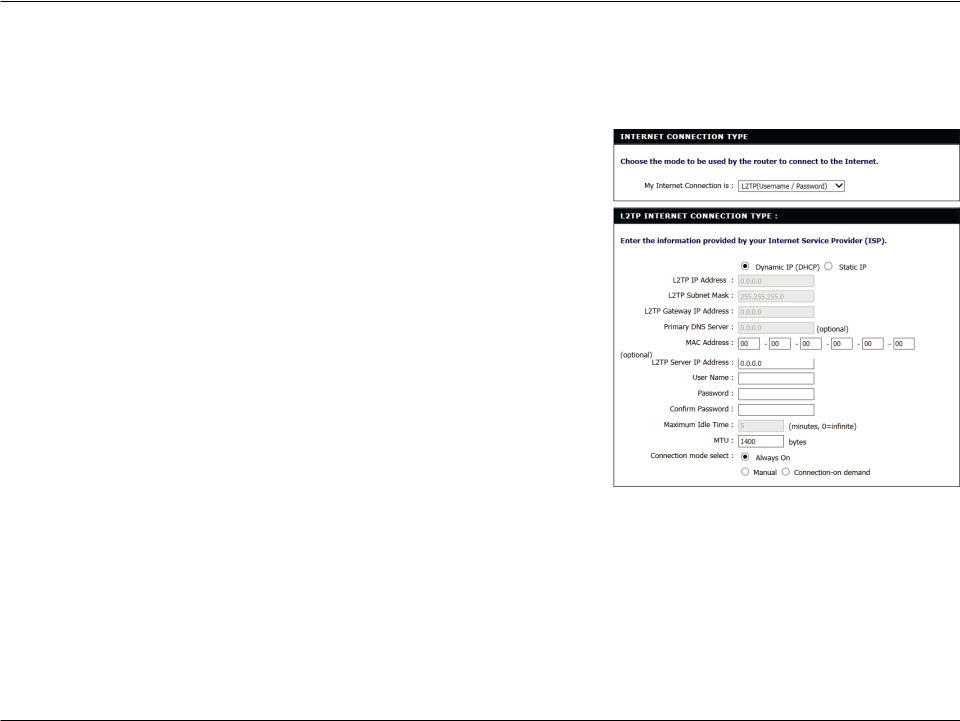
Section 3 - Configuration
L2TP
Choose L2TP (Point-to-Point-Tunneling Protocol ) if your ISP uses a L2TP connection. Your ISP will provide you with a username and password.
My Internet Select L2TP (Username/Password) from the drop-down menu.
Connection:
Address Here the user can specify whether this Internet connection requires the Mode: use of a dynamic or static IP address. L2TP usually requires a
dynamic IP configuration.
L2TP IP Enter the L2TP IP address used here. This
Address: option is only available if Static IP is selected.
L2TP Enter the L2TP subnet mask used here.
Subnet
Mask:
L2TP Enter the L2TP gateway IP address used here.
Gateway IP Address:
Primary Enter the primary DNS IP address used here.
DNS Address:
MAC The default MAC address is set to the WAN’s physical interface MAC ad- Address: dress on the broadband router. It is not recommended that you change
the default MAC address unless required by your ISP.
You can use the Copy Your PC’s MAC Address button to copy the MAC address of the Ethernet card installed by your ISP and replace the WAN MAC address with the MAC address of the router. It is not recommended that you change the default MAC address unless required by your ISP.
D-Link DIR-809 User Manual |
24 |
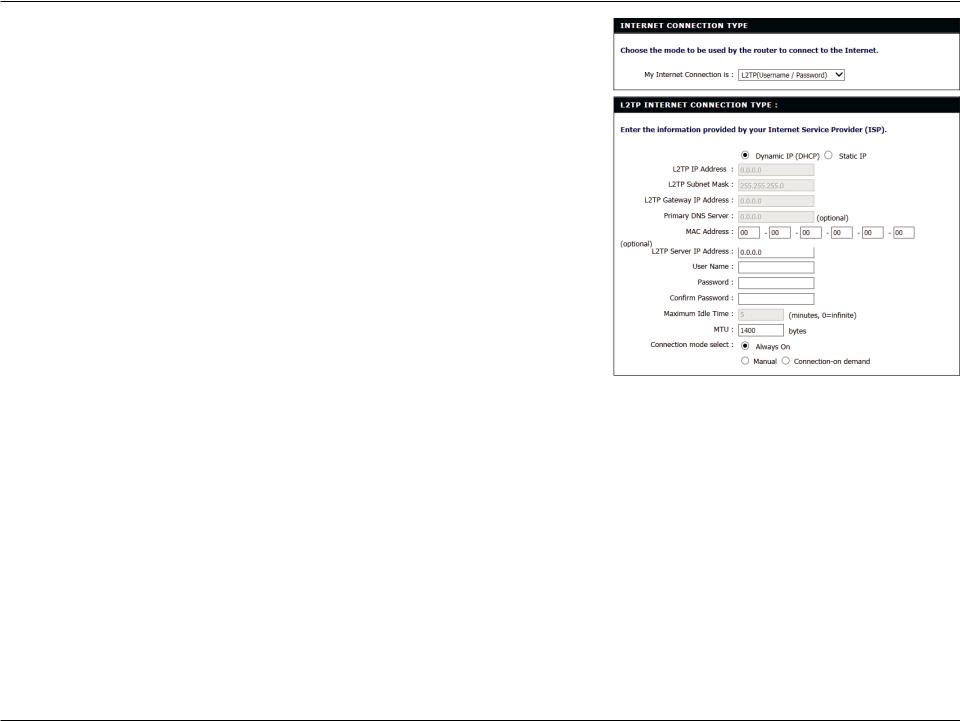
Section 3 - Configuration
L2TP Server Enter the L2TP server IP address used here. This is normally the same as IP Address: the L2TP gateway IP address.
User Name: Enter the L2TP username used here.
Password: Enter your L2TP password, then retype the password in the next box.
Maximum Enter a maximum idle time during which the Internet connection is main- Idle Time: tained during inactivity. To disable this feature, enable Auto-reconnect.
MTU: Maximum Transmission Unit - You may need to change the MTU for optimal performance with your specific ISP.
Connect Select either Always-on, Manual, or Connect-on demand.
Mode
Select:
D-Link DIR-809 User Manual |
25 |

Section 3 - Configuration
Wireless Settings
Wireless Mode: The DIR-809 may be used as a Wireless Router, Access Point, or a Repeater on either the 2.4 GHz or 5 Ghz bands.
Wireless Router Mode
In Wireless Router Mode, the DIR-809 connects to your cable modem, DSL modem, or other Internet source and shares your Internet connection with your devices wirelessly, providing Internet access for an entire home or office. See “Wireless Router Mode” on page 29 for configuration options.
Internet Cable/DSL Modem |
Wireless Devices |
D-Link DIR-809 User Manual |
26 |
